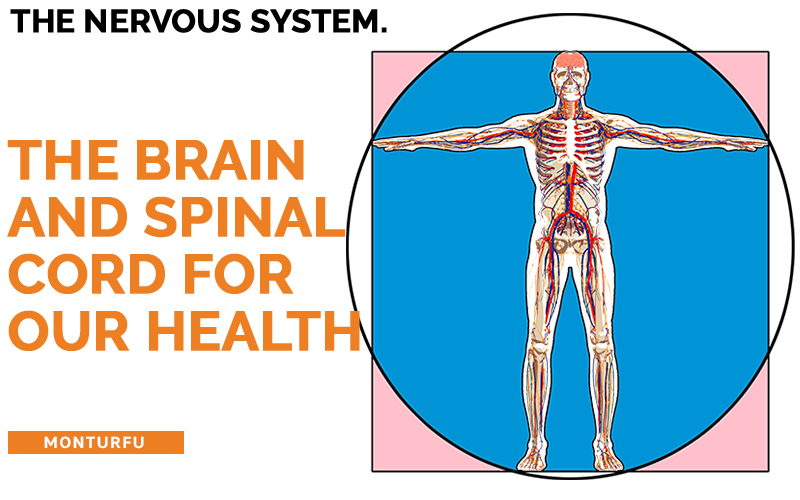THE NERVOUS SYSTEM CERGY.
THE BRAIN AND
SPINAL CORD
FOR OUR HEALTH
The nervous system receives information from the sensory organs via the nerves. It then processes this information in the brain. Then it transmits this information via the spinal cord to the different cells and organs. The nervous system directs our body’s reactions to the stimuli. The nervous system directs the reactions of our body to the realities of the outside world.
At the same time it controls and regulates most of our internal functions.
What is the nervous system-Cergy ?
The nervous system is the most fragile organ and the most complex and organized system in the human body.
It is a collection of nerves and nerve cells, or neurons, that carry signals and messages from the brain and spinal cord to different parts of the body and back. It is composed of the central nervous system and the peripheral nervous system.
What is the CNS ?
The brain and spinal cord make up the central nervous system. On the one hand, the brain controls most of the body’s functions. These include :
- motor skills, movements, balance,
- perception, sensitivity, vision, hearing, smell etc…
- intellectual functions, emotions, thoughts,
- sensations, behavior, speech, memory,
- as well as the functioning of certain organs like the intestine or the bladder…
On the other hand, the spinal cord circulates the nerve signals, and allows them to go back and forth betweenthe brain and the nerves of the rest of the body. The spinal cord is attached to the brain at the level of the brain stem. This is how the vertebrae form the spine and protect the spinal cord. Nerves then emerge from the spinal cord to innervate both sides of the body.
At the heart of the distribution of nerve impulses.
The brain and spinal cord, the CNS, is the control center. They receive data and reactions from the sensory organs and nerves connected to the whole body. They both process the information and send orders in return.
This transmission of information is done in the form of a nerve impulse, that is to say an electric current propagating along the extensions of the neurons.
It is therefore the movement of electrically charged molecules, namely ions, that generates this bioelectric current through the membrane of the neurons.
The central nervous system contains essentially two main types of cells :
- neurons ;
- and the glial cells.
The neurons.
They transmit information in the form of a bioelectric current from one point to another in the CNS. Neurons are extremely numerous : about 100 billion per person.
Neurons make up the entire nervous tissue, from the brain to the spinal cord, to the furthest nerve branch. They are polarized cells. They carry bioelectric signals to transmit information throughout the body.
Zoom in on a neuron.
Typically, a neuron consists of a cell body, dendrites and an axon with an axonal termination. The dendrites receive signals from body tissues or other neurons and transmit them to the cell body. If an outgoing signal is produced, it travels along the axon and reaches the axon terminal. It is then transmitted to the next neuron or to the target cell.
Glial cells of the nervous system-Cergy.
These cells feed, maintain, isolate and communicate with neurons. They are 10 times more numerous than neurons. Among the glial cells, we distinguish :
- astrocytes, support and communication cells ;
- oligodendrocytes, cells that synthesize myelin;
- microglial cells, which clean and monitor the nervous system.
What is myelin?
The axon, a kind of electrical cable, can be extremely long. It carries nerve impulses from the CNS to the rest of the body, for example from the brain to the spinal cord.
The myelin sheaths protect the axon. They are therefore a kind of electrical insulator that allows the rapid propagation of nerve impulses.
The neurons of the nervous tissue broadcast ultra-fast signals.
In order for the message to be transmitted quickly and efficiently over a long distance, a membrane sheath surrounds the axon, wraps around it several times and compacts itself. This is the myelin sheath.
This sheath is a kind of electrical insulator that accelerates the conduction of nerve impulses.
The neurons broadcast ultra-fast signals.
In order for the message to be transmitted quickly and efficiently over a long distance, a membrane sheath surrounds the axon, wraps around it several times and compacts itself. This is the myelin sheath.
This sheath is a kind of electrical insulator that accelerates the conduction of nerve impulses.
Optimization of the influx process.
The cells in charge of synthesizing myelin are oligodendrocytes. An oligodendrocyte can myelinate several axons, but covers only a short portion of each one. The myelination of axons thus occurs in successive myelin sleeves, separated by small non-myelinated portions, which are called nodes of Ranvier.
The nerve impulse jumps from one node of Ranvier to another, while the myelin sheaths isolate the other segments of the axon.
The nerve impulse travels at high speed.
The propagation of the nerve impulse is done in a discontinuous way; this makes it possible to conduct information quickly over large distances, while saving energy. This type of conduction is much faster. The impulse does not run all the way along the axon.
This conductive capacity makes it possible to send information up or down the nerve pathways at any speed, as well as throughout the central nervous system. And it is obviously thanks to its 100 billion neurons and 1000 billion glial cells that the brain has exceptional processing power.
The mechanism of the nerve impulse.
Messages from the nervous system travel through neurons in the form of bioelectric signals. And these signals arrive at the termination of a neuron in the form of an action potential sequence. They then stimulate the release of chemicals called neurotransmitters.
Neurotransmitters are the activators of the nervous system-Cergy.
Communication between neurons takes place at the synapse. When the nerve impulse reaches the end of the axon, it causes the release of molecules, the neuromediators or neurotransmitters, in this very small space.
The neurotransmitters then circulate in the synapses.
The synapse is therefore the histological structure by which the axon of a neuron articulates with the dendrites of another neuron.
In fact, synapses are spaces between neurons or between neurons and other tissues or cells of the body. There are, so to speak, two categories of neurotransmitters : exciters and inhibitors.
Neuromediators in the service of organ regulation.
Excitatory neurotransmitters stimulate electrochemical signals in neurons and encourage the body’s cells to respond. In contrast, inhibitory neurotransmitters discourage signals and responses from the cells.
By binding to the second neuron, the neurotransmitters induce a signal that in turn generates an electrical impulse.
The number of synapses present on a neuron is variable, but generally in large quantities. 10.000 synapses per neuron on average.
It is therefore through these chemical substances that the nervous system regulates the activity of muscles, glands and its own nerve pathways.
What is the peripheral nervous system, PNS ?
The nerves and sensory organs, the ganglia constitute the peripheral nervous system. They both send signals to the CNS and receive signals from the Central Nervous System. In addition, the peripheral nervous system consists of the somatic nervous system and the autonomic nervous system.
A bundle of nerves provides the meshwork of the organs.
signals. 24 cranial nerves connect the brain to the eyes, ears and other sensory organs. They also connect the muscles of the head and neck. However, thirty-one pairs of spinal nerves branch off from the spinal cord and connect the tissues of the chest, abdomen and limbs. Thus, each nerve is responsible for transmitting sensory information and sending motor commands, or both.
What is the somatic nervous system-Cergy ?
The autonomic nervous system directs the involuntary functions of the body. The body itself controls these functions, including breathing and digestion.
Furthermore, the autonomic nervous system is subdivided into the following nervous systems :
- sympathetic,
- parasympathetic
- and enteric
The sympathetic nervous system- Cergy.
On the one hand, the sympathetic nervous system prepares the body for situations that require strength and heightened perception or that arouse fear, anger, excitement or discomfort. In fact, this is called the fight or flight response. As a result, the sympathetic nervous system increases the heart rate, speeds up breathing while making it shallower, dilates the pupils and stimulates the metabolism.
The parasympathetic nervous system.
In contrast, the parasympathetic nervous system has a calming effect on the body. At the same time, it allows the heart rate and breathing to return to normal. Thus, the pupils shrink and the metabolism slows down to conserve energy.
The spinal cord carries signals to and from the brain and controls reflexes.
The spinal cord is a cylinder of neuronal cell bodies, axon bundles and other cells. It is an extension of the brain from the medulla oblongata, in the center of the tunnel along the spine that protects it. The spinal cord distributes the nerves between the brain and the different parts of the body.
The role of the spinal cord.
It serves as a kind of information highway. Sensory information and motor commands travel up or down it, from or to the brain. These signals travel at high speed within or outside the spinal cord via the spinal nerves. The spinal nerves are the pathways that branch out from the spinal cord to the limbs, torso, pelvis, etc. Therefore, the spinal cord contains circuits of nerve cells that control coordinated movements such as walking, swimming, urination etc. Some incoming signals require a simple and immediate response. In fact, the spinal cord can initiate a reflex command without brain input.
The brain associates external perceptions with complex thinking, memory and emotions.
The nervous system does much more than transmit information and process orders. According to the popular understanding, the brain is organized in three levels. On the one hand, the reptilian brain is the seat of basic behaviors such as eating, drinking and reproducing. On the other hand, the limbic system which gives birth to emotions. And finally the cortex which authorizes abstract thought.
Indeed, the limbic system is one of the oldest parts of the brain. It is present in humans, but also in reptiles and fish.
The functions of the limbic system.
The limbic system is not only involved in emotions but also in :
- learning and memory,
- olfaction,
- the control of the endocrine system which participates in the release of hormones,
- eating behaviors and appetite,
- the autonomic nervous system which controls the respiratory, digestive and cardiovascular functions.
Anatomy of the limbic system.
The limbic system forms two even rings within the brain. It consists of the hippocampus, amygdala, cingulate gyrus and dentate gyrus, as well as other structures and pathways. As with other brain segments, the limbic system plays a role in many functions and levels of nervous system activity.
Together, the central nervous system, CNS, and the peripheral nervous system, PNS, transmit and process sensory information, and coordinate body functions. This highly energy consuming management on a human scale regulates the activity of our organs and ensures the survival of our species.
Ok de-MEDEIROS
SOURCES : https://www.visiblebody.com/fr/learn/nervous/system-overview, https://www.sep-ensemble.fr/la-sep-c-est-quoi/comprendre-systeme-nerveux-central, https://cancer.ca/fr/cancer-information/cancer-types/neuroblastoma/what-is-neuroblastoma/the-nervous-system, https://www.futura-sciences.com/sante/definitions/biologie-systeme-nerveux-autonome-13244/, https://www.sep-ensemble.fr/la-sep-c-est-quoi/comprendre-systeme-nerveux-central, https://www.futura-sciences.com/sante/definitions/biologie-moelle-epiniere-2330/, https://www.neuromedia.ca/le-systeme-limbique/, https://www.clipartkey.com/view/hbohbT_nervous-system-diagram-unlabeled/, https://www.clipartkey.com/view/bowiTo_png-image-with-transparent-background-application-of-collagen/






Laisser un commentaire